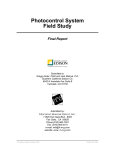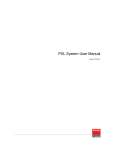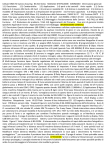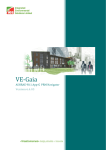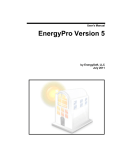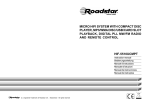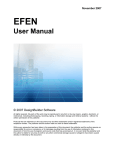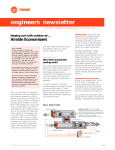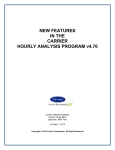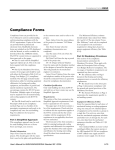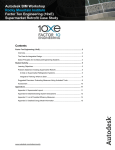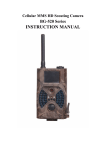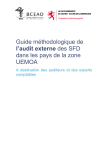Download ETO Custom Track Technical Guidelines
Transcript
Energy Trust of Oregon
New Buildings Program
Technical Guidelines
Ver. 8 120809
Section 1 Introduction .................................................................................................. 3
1.1 Oregon Code Requirements .............................................................................. 3
1.2 Custom Track (2007 Code Projects) .................................................................. 4
1.3 Modeled Savings (2010 Code Projects) ............................................................. 4
Section 2 Energy Simulation Requirements and Guidelines ....................................... 5
2.1 Energy Simulation Program Selection................................................................ 5
2.2 Baseline model Selection, adjustments and System Mapping ........................... 5
2.3 Cost-Effectiveness Requirements and Measure Bundling ................................. 9
2.4 Modeling Interactive Effects ............................................................................. 13
2.5 Energy Modeling Best Practices ...................................................................... 14
Section 3 Spreadsheet and Manual Calculations ...................................................... 16
Section 4 State Energy Efficiency Design (SEED) Program Projects ........................ 17
4.1 State Energy efficiency Design Program Projects (SEED)............................... 17
Section 5 Energy Analysis Documentation ................................................................ 18
Appendix A .................................................................................................................... 22
Appendix B .................................................................................................................... 24
Appendix C.................................................................................................................... 29
Appendix D.................................................................................................................... 37
Appendix E .................................................................................................................... 38
Appendix F .................................................................................................................... 39
Section 1
Introduction
Energy Trust of Oregon’s New Buildings program (Program) provides assistance to project
owners, architects, engineers, contractors and others involved in commercial and industrial new
construction and major renovation projects. Projects designed to include the installation of
energy efficiency measures may be eligible for cash incentives and technical assistance.
In 2009, the Oregon legislation (Senate Bill 79) was approved and signed into law which, among
other things, directed the Director of the Department of Consumer and Business Services
(subject to the approval of appropriate advisory boards) to adopt amendments to the state
building code designed to reduce energy use in commercial construction by 15-25% over 2007
code provisions by 2012. Because projects which are permitted under the 2010 code will now
have a different baseline than those permitted under the 2007 code, this change has prompted
a redesign of our Program offerings. The Oregon energy code that a project is subject to
will determine which application forms a project owner should complete and which
incentives will be available from Energy Trust.
These Technical Guidelines describe the technical requirements that projects enrolled in either
the Custom Track (2007 code projects) or submitting a Modeled Savings Incentive
Application (2010 code projects) must meet to qualify for Energy Trust incentives.
Under each of the aforementioned Program offerings, Energy Trust makes cash incentives
available for the installation of building systems that are more energy efficient than those
installed to meet minimum Oregon energy code requirements/standards in the same type
building with similar occupancy. Any measure that contributes to reducing the overall energy
consumption of the proposed design over that of a baseline building can be considered an
energy efficiency measure (EEM). These items are typically related to the envelope,
mechanical, electrical, lighting, and building controls systems.
The project owner’s energy analyst will estimate first-year annual electric and gas savings of the
EEMs through an energy model or other energy analysis, as described in these Technical
Guidelines. The energy analyst will identify EEMs that pass the Program’s Cost-Effectiveness
Calculator test (see Section 2.3) and that have a simple payback period greater than one year
for recommendation to the project design team. The analyst will submit the analysis to the
Program for review in the form of an Energy Analysis Report. By its submittal of the analysis
to the Program, the analyst represents that it has the authority to submit the analysis on behalf
of project owner and that the analysis is truthful and accurate to the best of its knowledge and
has been performed in accordance with these Technical Guidelines.
An Energy Analysis Report Template, Savings Summary Worksheet for 2007 Code, and
Savings Summary Worksheet for 2010 Code are available on the Energy Trust website at
energytrust.org/business.
1.1
OREGON CODE REQUIREMENTS
Effective July 1, 2010, the Oregon Building Codes Division adopted the 2010 Oregon Energy
Efficiency Specialty Code (OEESC) to regulate the design and construction of buildings for the
effective use of energy. With this code change, Oregon’s energy code, the 2010 OEESC, is now
a stand-alone code and takes the place of Chapter 13 in the 2007 Oregon Structural Specialty
Energy Trust of Oregon - Technical Guidelines
3
Code (OSSC). During a phase-in period, from July 1, 2010 to September 30, 2010, building
officials allowed the use of either the 2010 OEESC or Chapter 13 in the 2007 OSSC.
Whether a project is subject to the 2007 or 2010 version of the Oregon energy code will impact
these Technical Guidelines and other Program requirements. In instances where a project is
exempt from Oregon code compliance or no code requirement is specified, the Program will
accept common industry practice or relevant ASHRAE standards to establish the baseline.
1.2
CUSTOM TRACK (2007 CODE PROJECTS)
For enrolled 2007 code projects seeking Custom Track incentives, the Program does not
dictate any specific required analytical approach. Custom spreadsheets, building energy
simulation models, manufacturer’s calculator tools, and other analyses recognized as standard
engineering practice are considered acceptable. The analysis should reflect good engineering
practice with a level of effort consistent with the complexity of the EEMs being considered.
Regardless of the analytical approach, an Energy Analysis Report and Savings Summary
Worksheet for 2007 Code are required as part of the Custom Track (see Section 5).
Spreadsheet and manual calculation requirements are described in Section 3.
Modeling requirements are discussed in the following sections:
•
Projects must use acceptable baseline system mapping, selection and assumptions as
described in Section 2.2.
•
EEMs must be modeled individually and tested for cost-effectiveness unless bundling
exceptions are allowable, as described in Section 2.3.
•
Interactive effects between EEMs must be accounted for in the analysis as described in
Section 2.4.
•
Documentation requirements are described in Section 5.1.2.
1.3
MODELED SAVINGS (2010 CODE PROJECTS)
For enrolled 2010 code projects seeking Modeled Savings incentives, the Program requires
building energy simulation models. An Energy Analysis Report and Savings Summary
Worksheet for 2010 Code are also required (see Section 5).
Building energy simulation requirements include:
•
Projects must use acceptable baseline system mapping, selection and assumptions as
described in Section 2.22.1.
•
EEMs must be modeled individually and tested for cost-effectiveness unless bundling
exceptions are allowable, as described in Section 2.3.
•
Interactive effects between EEMs must be accounted for in the analysis as described in
Section 2.4.
•
Documentation requirements for energy simulations are described in Section 5.1.2.
Energy Trust of Oregon - Technical Guidelines
4
Section 2
2.1
Energy Simulation Requirements and Guidelines
ENERGY SIMULATION PROGRAM SELECTION
Since there are limitations in the accuracy of modeling some EEMs with building energy
simulation software, it is up to the energy consultant to choose a program that is appropriate for
the anticipated EEMs.
If the selected energy simulation program cannot explicitly model an EEM, the analyst may
utilize a thermodynamically similar component model that can approximate the expected
performance. For example, CFD modeling is effective at optimizing natural ventilation openings,
quantifying airflow rates and predicting temperatures in the space. Such information is useful in
creating informed input variable for energy simulation software. Analysts may utilize industry
accepted methodologies when deficiencies in the model will not accurately calculate savings.
2.2
2.2.1
BASELINE MODEL SELECTION, ADJUSTMENTS AND SYSTEM MAPPING
SEED Appendix L 1
The energy analyst must generally model the baseline and proposed facility using Oregon’s
State Energy Efficiency Design (SEED) program’s Building Modeling Guidelines Appendix L 2,
regardless of whether or not the facility is participating in the SEED program. Section 2.2.3
describes acceptable deviations from SEED Appendix L that are allowable in Energy Trust's
Program. Projects permitting under the 2010 code must reference the revised version of SEED
Appendix L, dated October 1, 2010. In all cases the baseline must meet the minimum
requirements of the Oregon energy code under which the project is permitted.
2.2.2
Program Changes to SEED Appendix L
For Energy Trust's purposes, the Program has made changes to SEED Appendix L (see
Appendix A) based on standard design practice and OEESC requirements.
SEED Appendix L doesn’t define all Oregon code requirements, but focuses instead on the
significant energy modeling parameters needed to define typical building energy systems. Code
requirements not highlighted in SEED Appendix L still need to be accounted for by the energy
analyst. Energy systems not regulated by the Oregon code must be modeled according to
standard design practice (see Section 2.2.3 for examples). When common design practice is
more stringent than a particular energy code requirement, the common design practice should
take precedence. Standard design practice assumptions made by the modeler will be reviewed
by the Program technical reviewers. Determination of standard practice has proven to be
particularly important in specialty applications such as: data centers, central plants, swimming
pools, hospitals, laboratories, arenas and industrial applications.
1
ASHRAE 90.1-2007 Appendix G is currently being investigated by the Program for adoption into the Technical Guidelines.
Projects that wish to reference Appendix G instead of SEED Appendix L should contact the program to determine if any adjustments
must be made to the baseline model.
2
It should be noted that SEED Appendix L was developed from ASHRAE 90.1 Appendix G and contains modifications and
enhancements to comply with the intent of the OSSC Chapter 13 (2007 code version) and OEESC Chapter 5 (2010 code version).
Energy Trust of Oregon - Technical Guidelines
5
2.2.3
Acceptable Deviations from SEED Appendix L or Code
While the defined baseline requirements outlined in SEED Appendix L and OEESC are
applicable to most buildings and systems, there are some instances in which the baseline
assumptions appear to be inappropriate or unrealistic, or may limit the project’s potential energy
savings. The energy analyst is encouraged to contact the Program to discuss the baseline
system selection and assumptions. During the model review, the Program may request that the
analyst choose an alternative baseline HVAC system type that best represents industry
standard practice.
The following criteria are used by the Program to determine if an energy analyst may deviate
from the SEED Appendix L HVAC system mapping or code requirements.
2.2.3.1
HVAC system mapping exceptions
While the defined HVAC mapping process outlined in SEED Appendix L generally works well
there are some cases where the assigned baseline HVAC energy system is inappropriate and
limits the project’s potential energy savings. Common central HVAC systems, such as a variable
air volume (VAV) system, generally serve medium to large buildings and can be inefficient
because of the reheat energy associated with trying to serve cooling and heating loads with one
common air duct. In addition to large reheat loads, the fan energy required to push air through
an extensive ducting system is energy intensive.
Distributed HVAC systems consist of many smaller fan units or passive heating and cooling
elements located throughout the building that generally serve individual zones. Zone
temperature is controlled by applying heating or cooling as needed, removing the risk of
simultaneously heating and cooling associated with a VAV system. Below are some examples
of typical distributed system types:
•
•
•
•
Passive radiant heating and cooling
Active radiant heating and cooling
Variable refrigerant flow (VRF) heat pump systems
Water source heat pump systems
SEED Appendix L defines the baseline HVAC system for 2-story buildings less than 40,000 sq.
ft. as a distributed HVAC system with packaged single zone systems. Standard design practice
would suggest the baseline system would be a central VAV system. For situations were a VAV
system would be a more appropriate baseline, VAV systems may be modeled in the baseline
provided that supporting justification for the baseline switch is submitted by the analyst. Below
are examples of criteria that may warrant modeling a VAV system in the baseline:
•
•
•
•
Building must have cooling;
Buildings that feasibly would not work well with packaged single zone systems (e.g. if
structural constraints require smaller ductwork common to VAV systems, if there are
roof space limitations, if there is a large diversity of interior and perimeter zones, etc.);
Single story buildings must be larger than 20,000 sq. ft.; multistory buildings must be
larger than 15,000 sq. ft.;
Building type must be office. Other building types, such as large education or retail,
must provide justification for why a VAV system should be applied in the baseline. No
residential or multifamily buildings.
Energy Trust of Oregon - Technical Guidelines
6
2.2.3.2
Specific SEED Appendix L exceptions
Analysts are encouraged to work with the Program to establish an appropriate baseline when
the SEED Appendix L baseline is unrealistic. Below are examples of adjustments to Sections
of SEED Appendix L that are allowable:
•
Section 3.7- Lighting allowances for automatic lighting controls limits the reduction in
lighting power modeled for daylighting or occupancy controls to 5-10%. An allowance
may be taken for projects modeling occupancy and daylighting controls up to a 25%
reduction in lighting power, where they are not required by code. This aligns with the
Lighting Calculator assumptions used in other Program offerings.
•
Section 4.3.1- Code Baseline HVAC System Type and Description defines the HVAC
system type to be used in the baseline model. The system mapping described in
Tables 4.8 and 4.9 may not be appropriate or compatible with the proposed building
type. For example a 3-story 20,000 sq.ft. building would be required to model a VAV
system with chilled water coils and reheat in the baseline, whereas a VAV system with
DX coils may be more typical for that building type and size. Analysts should contact
the Program to determine if a different baseline system (e.g. ASHRAE 90.1-2007
Appendix G baseline system mapping) may be used. It is recommended that this be
established early in the design process, preferably when the analyst submits a
proposed energy analysis plan to the Program.
•
Section 4.3.2.7 Economizers requires an integrated economizer on code systems
anytime the outdoor air temperature is less than 70˚F. Code baseline building systems
may adjust the baseline model economizer assumptions with the following configuration
in an effort to reflect actual economizer operation:
o
o
Packaged equipment with DX coils 3 – economizer cooling anytime the outdoor
drybulb temperature is less than 60°F
Equipment with cooling coils – economizer cooling anytime the outdoor drybulb
temperature is less than the return air temperature.
Economizer change over temperature should be held fixed in both the proposed and
code baseline unless HVAC equipment changes from packaged DX to cooling coils or
vice versa.
2.2.3.3
Specific code requirement baseline exceptions
Analysts are encouraged to work with the Program to establish an appropriate baseline when
the code baseline assumptions are unrealistic. Below are examples of adjustments to the
baseline energy model that are allowable.
•
Window U-Value: The code U-value for windows varies based on material type. For
example, in the 2010 Oregon code, metal frame windows must have a U-value=0.45,
while non-metal (wood, vinyl, or fiberglass) must have a U-value=0.35. Non-metal frame
windows have very low market share in commercial buildings, even though they have
higher performance compared to metal framed windows. Projects utilizing non-metal in
3 Packaged DX cooling equipment have internal control to prevent simu taneous economizer cooling and compressor cooling to prevent coil freezing
l
at low load conditions.
Energy Trust of Oregon - Technical Guidelines
7
the frames in the building may model metal framed windows in the baseline model, i.e.
U-value=0.45 for 2010 code projects.
•
Dedicated Outside Air Systems (DOAS) with Distributed Heating and Cooling Units:
Code allows two methods for providing ventilation air in distributed heating and cooling
systems:
o
o
Ventilation air can be introduced locally through a direct outside air duct. This
method is often less expensive (less duct work), but limits the potential for heat
recovery.
A central ventilation system can be used; however, if the ventilation rate is larger
than 5,000 CFM, 2010 Oregon energy code would require heat recovery.
Projects pursuing distributed heating and cooling systems with centrally ducted
ventilation may model the baseline with no heat recovery, provided the total ventilation
air is less than 12,000 CFM.
•
Water Cooled vs. Air Cooled Condenser Cooling Systems: The minimum code-required
efficiency for a chiller is dependent on the chiller type selected. Projects adopting higher
efficiency water cooled systems may model the baseline system as an air cooled chiller
for the following system types:
o Water cooled chillers less than 300 tons
o Rooftop packaged equipment with chilled water coil served by water cooled
chiller vs. RTUs with DX mechanical cooling
2.2.3.4
Project or system-specific baselines
When there is no clear code requirement for a specific modeling parameter, the analyst should
reflect on what common design practice would dictate. When common design practice is more
stringent than a particular energy code requirement, the common design practice should take
precedence.
Appendix B documents acceptable baseline and general modeling assumptions for the
equipment, scenarios or building types identified in Table 2-1.
Table 2-1: Project specific baseline assumptions noted in Appendix B
System or Equipment Type
Waterside economizers
Condenser water reset strategies
Existing facility loads
Loads and redundancy
Dehumidification systems for swimming pools
and spas
Building Type
Grocery Stores
Hospitals
Light Industrial Applications
For projects or systems that are unclear or that need further interpretation, the analyst should
contact the Program.
For projects participating in the data center offering, please see Appendix C for requirements.
Energy Trust of Oregon - Technical Guidelines
8
2.2.4
Avoiding Fuel Switching
Energy Trust cannot provide financial incentives for measures for converting or replacing
electric or gas equipment to another fuel 4. For new construction projects, the baseline system
and proposed system being modeled must use the same fuel types, though not necessarily the
same system types. Similarly, individual measures must be compared against baselines with
the same fuel (e.g., electric-to-electric, gas-to-gas). Analysts modeling hybrid systems should
select hybrid baseline systems as specified in Table 4.8 and 4.9 of SEED Appendix L. Below
are several examples of appropriate and inappropriate baseline selections for Program
purposes. Additional detailed information on system specific fuel switching issues (e.g. pool
dehumidification systems) is also provided in Appendix B.
Acceptable baseline selection:
•
•
A VAV system with electric reheat has an electric heat source; therefore, the baseline
model should be a VAV system with fan powered boxes with electric resistance.
A water-source heat pump system with a supplemental boiler is a hybrid system;
therefore, the baseline system must also utilize electric and gas heating sources, such
as packaged AC units with a gas furnace.
Unacceptable or ineligible fuel system mapping:
•
•
2.3
A building is modeled with air handling units with hot water coils served by a gas boiler in
the baseline. The proposed design utilizes a more efficient envelope, thus minimizing the
heating load significantly such that the system type is switched to packaged RTU’s with
small electric heating coils. In this case, the fuel has been switched from gas (baseline)
to electric (proposed) and therefore would not be eligible for incentives for the switch in
heating system unless the baseline is updated to an electric fuel source.
A packaged single zone system with a waste-oil heater has a waste-oil heat source.
Regardless of the baseline fuel source, this system would not be eligible for incentives
because there will always be a switch in fuel types from electric or gas to waste-oil when
comparing the baseline and proposed models.
COST-EFFECTIVENESS REQUIREMENTS AND MEASURE BUNDLING
All measures must be analyzed individually to quantify energy savings for cost-effectiveness
screening unless noted in the sections below. The following sections describe the costeffectiveness tests and instances in which measures may be bundled together for costeffectiveness.
2.3.1
Benefit-to-Cost Ratio Test
Individual measures must pass a benefit-cost ratio test using the Cost-Effectiveness
Calculator (CEC), which can be found in the Savings Summary Worksheet for 2007 Code
and the Savings Summary Worksheet for 2010 Code. Select the "Instructions" tab for
instructions on how to use the worksheet.
Using the Cost-Effectiveness Calculator tab, each individual measure (or “bundle” of related
measures, as described in Sections 2.3.2 through 2.3.5) must have a benefit cost ratio (BCR) of
4
See Fuel Switching Policy Memo at energytrust.org/library/policies/4.03.000-P.pdf
Energy Trust of Oregon - Technical Guidelines
9
at least 1.0 for both societal and utility cost effectiveness tests, as determined by the Program. It
is beneficial for the societal test to include other quantifiable non-energy cost savings or added
value resulting from the measure, such as reduced maintenance or inventory, water savings,
improved market value, improved marketability, etc. An explanation and supporting
documentation regarding such non-energy cost savings must be included in the appendix of the
Energy Analysis Report.
Typically, the sum of individual measure savings is greater than the actual achievable savings
because of interactive effects between measures. When the values for the individual measures
do not sum to the final interactive model, the values are pro-rated using a weighted average.
Adjustment of the individual measure savings values are automatically performed in the
Savings Summary Worksheet. The adjusted values are used in the BCR evaluation.
An approximation of the value of a single measure when acting in concert with all other
measures is made by normalizing the individual values such that they sum to the interactive
total by:
IMCEC = (IM)*(Int)/(∑IM)
Where:
IMCEC = Individual measure value to be used in the CEC
IM = Individual measure value returned from model
Int = Total interactive combined case of all measures
∑IM = Total of individual measure values returned from model
2.3.2
Pre-approved Measures for Cost-Effectiveness Screening
Pre-approved energy measures have been defined in Table 2-2. These are measures that have
repeatedly proven to be cost effective and don’t require project-specific cost-effectiveness
analysis. Measures in this table are measures that are commonly bundled together for SEED
projects, measures that have been evaluated as Standard measures, or measures that have
proven to be cost-effective in the HVAC and Lighting Calculator tools.
At the energy analyst’s discretion, any of the pre-approved energy measures from this list can
be bundled together for cost-effectiveness screening. For each pre-approved measure, an
efficiency limit has been set which represents that highest efficiency that was found to be costeffective. Analysts working on a project with measures exceeding these limits should contact the
Program to determine if the measures can be incorporated into the bundle of measures. To
utilize the pre-approved measures, the analyst should prepare two baseline models: the code
baseline model and the baseline model with the pre-approved measures bundled together. The
pre-approved measures must be evaluated for cost-effectiveness as a group, so an incremental
cost for the group of measure must be submitted with the project.
Energy Trust of Oregon - Technical Guidelines
10
Table 2-2: Pre-approved Measures
2.3.3
Individually Analyzed Measures
In general, measures not included in Table 2-2 must be analyzed individually for cost
effectiveness. A list of measures requiring individual analysis is available in Appendix D.
Analysts are encouraged to use this measure list as a resource during project scoping or early
design meetings to identify potential efficiency strategies and measures.
2.3.4
Bundling of Measures
In some cases measures may be bundled together for cost-effectiveness screening, instead of
being screened individually. Measure bundling is allowed when the measures have strong
Energy Trust of Oregon - Technical Guidelines
11
positive energy savings interaction (i.e., they save more together) or when the measures can be
purchased, constructed and/or installed at significantly lower cost together 5. In other words:
Bundled Measure
Savings or Cost
(A+B)
Individual Measure
Savings or Cost
>
A+B
Measures that are interactive or interdependent in these ways should be bundled together.
Measure bundling may also be allowed if a measure is not cost-effective alone but is costeffective with an enhancement, provided that enhancement could not technically work on its
own. The following examples highlight some typical cases, but it is expected that bundled
measures will vary by project type and building operating characteristics.
2.3.5
•
Improved envelope measures that reduce mechanical equipment costs: Envelope
measures can be bundled with HVAC measures when envelope improvements are
significant enough to allow for a substantial reduction in mechanical equipment size.
The reduced mechanical equipment cost savings can be credited towards the added
envelope measure costs.
•
Architectural daylighting features and lighting control design: Architectural features
such as exterior overhangs and fins or interior light shelves may be added to
enhance daylight harvesting and create greater lighting savings. These same
architectural features have a secondary benefit of blocking direct sunlight and solar
heat gain from entering the building. The resulting reduction in cooling load adds
additional savings. These effects all stem from the same measure. If the lighting
savings are significant enough to allow reduction in mechanical equipment size, the
mechanical equipment cost savings can be credited towards the daylight dimming
controls and architectural features.
•
Data center waterside economizer and hot/cold aisle separation: Hot and cold aisle
separation allows warmer supply air temperature to be provided to the servers, thus
increasing the number of waterside economizer operating hours. Evaluating these
two EEMs as a bundle will typically identify greater energy savings than if these
EEMs are assessed individually.
Adjusted Cost-effectiveness Requirements for Emerging Technologies
Energy Trust seeks to encourage promising innovative energy systems and emerging
technologies. Some measures which are new to the market have “early adopter” cost premiums
which adversely affects measure cost-effectiveness. While these measures may not currently
pass the Program’s cost-effectiveness requirements, they may become cost-effective in the
near future due to increased field experience or higher sales volume. To encourage the
adoption of these measures, Energy Trust may allow non-cost-effective measures according to
the following criteria:
•
Measures must be on the Emerging Technologies list in Table 2-3.
5
Minor volume discounts (i.e. a reduction in cooling load from 10 tons to 9.5 tons) do not meet the requirements for bundling, as
there must be a reason why the cost is significantly lower- enough that the less cost-effective measure might pass.
Energy Trust of Oregon - Technical Guidelines
12
•
•
Measures must have a Societal System BCR = 0.80 or greater.
The final interactive model, including all pre-approved or individually analyzed measures,
must have a Utility System BCR and Societal BCR greater than 1.0.
Table 2-3: Emerging technologies that qualify for a relaxed BCR = 0.8
Emerging Technologies
Radiant heating and cooling panels / chilled beams
Radiant heating and/or chilled floors
Evaporatively cooled HVAC units
Dedicated outside air system (DOAS) with heat recovery
Natural ventilation system without hybrid back up system
Heavy massed building without a mechanical refrigerant cooling system
Ground source heat pumps
Low temperature air source heat pumps
Displacement ventilation systems
Energy recovery chillers
Air-to-water heat pumps for waste-heat recovery off of exhaust air (e.g. bathroom
exhaust)
Tankless condensing water heaters for space heating in small commercial
applications
VAV systems with separate HVAC units for perimeter and core zones to minimize
reheat
VAV systems with secondary cooling unit serving high loads to allow aggressive
supply air temperature reset
2.4
MODELING INTERACTIVE EFFECTS
When measures are evaluated individually for cost-effectiveness, the interactions between the
measures are not captured.
It is likely that the algebraic sum of the energy savings of the measures calculated individually
will not equal the total energy savings calculated from the interactive model. Since the
interactive model incorporates the interactive affects of all the EEMs, the Program considers it
the most accurate method for calculating the whole building energy savings.
The “EEM Inputs” tab of the Savings Summary Worksheet will automatically adjust the
savings for each measure using a weighed average approach such that the summation of the
individual energy savings will not exceed the savings of the interactive model. These weighted
energy savings are used in the cost-effectiveness screening, which can be seen in the CostEffectiveness Calculator tab. See 2.3.1 for more details on the weighted average
methodology. Incremental costs for the measures are not modified by the spreadsheet.
Energy Trust of Oregon - Technical Guidelines
13
2.4.1
Interactions between Standard and Modeled Savings Measures
Projects that are also applying for Program incentives for measures other than those identified
for Modeled Savings (2010 code projects) or Custom Track (2007 code projects) must
incorporate those measures into both the baseline and proposed models. For example, a
Modeled Savings project that is applying for Standard measure incentives should incorporate
the performance requirements and characteristics of those Standard measures in both the
baseline and proposed models, rather than using the corresponding minimum code
requirements in the baseline model.
2.4.2
Interactions between Modeled Measures
The Program accepts the following three approaches for energy simulation modeling used by an
energy analyst to determine a measure's estimated energy savings. Regardless of the modeling
approach used, an interactive model must be created to quantify the overall savings and the
interactive savings must be indicated in the Savings Summary Worksheet.
Subtractive baseline: The as-designed building is run with all measures included. One measure
is removed and the model is rerun. That measure is put back into the model and another is
removed and the model is run again. This is done until all measures have been evaluated. The
difference between the total interactive run values and the values determined when the
measure is removed is considered the individual measure’s contribution.
This is viewed as the most conservative approach for ascertaining the savings associated with
individual measures.
Incremental or rolling baseline: The measures to be included in the design are consecutively
added to the model with a run made for each addition to estimate the effect of the individual
measure. It is possible that the sum of the individual savings will not equal the total for the
interactive model. Care should be taken in the ordering of measures; those that are most likely
to be implemented and most likely to be cost effective should be added first.
This is a more expensive approach. If a measure is removed or modified the model will have to
be rebuilt from the point where that element was changed in the model. It is less conservative
than the subtractive approach in measuring the effect of individual measures due to the fact that
they are not tested against the background of the rest of the measures.
Individual approach: The measures are tested one at a time in isolation against the baseline.
Selected measures are included in a final, interactive model. This is considered the least
conservative approach to estimating the effect of individual measures in the final building
design.
2.5
ENERGY MODELING BEST PRACTICES
This section describes modeling best practices for different systems and scenarios. Analysts
should use this section as a reference for some basic adjustments that should be made and
variables that should be checked in all energy models.
•
Baseline model energy use index (EUI): Baseline models sometimes have a low EUI,
which may indicate incorrect assumptions that result in lower energy savings. Energy
analysts are encouraged to check the baseline model EUI against the Commercial
Energy Trust of Oregon - Technical Guidelines
14
Building Energy Consumption Survey (CBECS) data or Pacific NW Commercial Building
Stock Assessment (CBSA) data.
•
Equipment loads: Modeling assumptions frequently underestimate the equipment load
of the building. Since equipment loads are required to be the same in both the baseline
and proposed models, this will cause the savings as a percentage of energy use to be
overestimated. Additionally, because the equipment gives off heat that increases the
cooling load, mechanical efficiency savings may be underestimated. The energy analyst
should ask the owner and design team about planned equipment and plug loads in the
facility in order to accurately estimate equipment loads and simulate building energy
consumption.
•
eQuest Quality Control Reporting tool: Analysts are encouraged to utilize the new
Quality Control Reporting tool within eQUEST (located in the “Tools” menu) that checks
a model’s EUI against national CBECS data. In addition there are several additional
built-in checks and features that flag any unusual inputs or outputs associated with
heating loads, cooling loads, unusual operating hours, lighting or miscellaneous loads,
fan operation, etc.
•
Examination of building operating hours: Energy analysts sometimes underestimate
energy savings due to using incorrect building operating hours in the energy models.
The energy analyst should ask the owner and design team about planned building
operations outside of normal occupied hours. For example:
•
Does the owner have a flexible schedule policy that allows employees to arrive
early or stay late?
•
What weekend work activity will occur?
•
eQuest wizard defaults: There are several eQUEST wizard input variables that need to
be overridden on most energy models. Appendix E highlights several default values that
should be reviewed by the energy analyst.
•
Available resources: Analysts are encouraged to reference energy modeling resources
that are publicly available. A list of known resources is detailed in Appendix F.
Energy Trust of Oregon - Technical Guidelines
15
Section 3
Spreadsheet and Manual Calculations
2007 code projects may submit spreadsheet or manual calculations instead of an energy model.
2010 code projects may submit spreadsheet or manual calculations only for measures that
cannot be accurately represented by an energy model. Analysts should contact the Program to
determine if a measure can be analyzed using a spreadsheet or manual calculation. Interactive
effects between these measures and modeled measures must be accounted for.
Spreadsheet or manual calculations must be performed in a manner that is clear and concise
and uses industry accepted methodologies. All assumptions, constants, and equations used in
the calculations must be clearly identified. Weather dependent measures, such as outside air
economizer measure, should be modeled using an hourly or bin-based approach utilizing
relevant data from the closest weather station so that site specific operating conditions are
captured in the savings estimate.
The analyst must determine the energy savings of each EEM by subtracting the proposed
annual energy consumption from the annual energy consumption of the corresponding baseline.
The baseline for each EEM must meet the requirements described in these Technical
Guidelines (see Section 2).
The analyst must also clearly identify the specific details (e.g. equipment and motor efficiencies,
operating schedules, fan speed percentages) for each EEM and the corresponding baseline
information used in the energy consumption calculations. The expected utility service provider
and corresponding rate schedule must also be clearly indentified, and these values should be
used in the energy cost savings calculations for each measure.
If spreadsheet and/or manual calculations are used for a project, all of the following information
must be included:
•
A list of all assumptions, constants, performance values, and equations
•
Interactions between measures should be accounted for in the calculations
•
Documentation to identify and substantiate the assumptions and basis for all usage
and weighting factors
•
Clear documentation for proprietary, analyst generated, and/or manufacturer
licensed spreadsheets/calculation tools. All formulas, assumptions and
corresponding cell references shall be clearly identified. Documentation provided
must give the Program reviewer a clear and logical progression of the results
obtained from such calculation tools. User interface input and output data sheets are
not acceptable substitutes for calculation documentation in lieu of the above
requirements.
•
All electronic spreadsheet calculations for each EEM, “unlocked”
•
All manual calculations for each EEM
To help expedite the review process, it is recommended that for spreadsheet calculations each
EEM be provided on no more than one spreadsheet file (multiple worksheets are permitted).
Multiple EEMs may be included in one spreadsheet using multiple worksheets as long as each
sheet clearly identifies the corresponding EEM.
Energy Trust of Oregon - Technical Guidelines
16
Section 4
4.1
State Energy Efficiency Design (SEED) Program Projects
STATE ENERGY EFFICIENCY DESIGN PROGRAM PROJECTS (SEED)
SEED program participants may be eligible for Energy Trust incentives if the building is served
by PGE, Pacific Power, NW Natural, or Cascade Natural Gas.
For projects participating in the SEED program, baseline EEMs identified and considered cost
effective by the SEED program may be combined as a single bundled EEM in the supporting
energy analysis and cost-effectiveness calculations submitted to the Program. The energy
savings and incremental cost data for each of the analyzed EEMs will be used in the Program's
cost-effectiveness calculations.
SEED projects must identify the estimated annual electrical energy, natural gas energy, and
energy cost savings between the code compliant building and the SEED building. Often SEED
Energy Analysis Reports tabulate savings results in terms of MMBtu. When using the
Savings Summary Worksheet SEED projects should clearly identify the electrical, natural gas,
and energy cost savings as follows:
For Baseline EEMs:
•
Provide the total bundled measure annual electrical (kWh), natural gas (therm), and
energy cost savings
•
Provide the total interactive bundled measure incremental cost
•
The measure life for the bundled baseline EEMs must be 17.7 years
The Program recognizes that SEED does not require cost effective analysis for the baseline
EEMs and that costs for these measures may not be readily available and will require additional
efforts by the analyst. However, the Program requires that the bundled package be screened for
cost effectiveness.
For Analyzed EEMs:
•
Provide the total annual electrical (kWh), natural gas (therm), and energy cost
savings for each EEM
•
Provide the incremental cost for each EEM
•
The measure lives for each measure must be those established by Energy Trust in
the Savings Summary Worksheet; SEED measure lives may not be used
Finally, the Energy Trust incentives will be based upon the total interaction between SEED
baseline EEMs and additional individual analyzed EEMs that meet the payback and benefit-cost
ratio criteria.
Energy Trust of Oregon - Technical Guidelines
17
Section 5
Energy Analysis Documentation
Project owners seeking Energy Trust incentives using either the Custom Track Incentive
Workbook (Form 520C) for 2007 code projects or the Modeled Savings Incentive
Application (Form 520MS) for 2010 code projects, must submit the following along with the
application form:
•
Completed Energy Analysis Report (.pdf format); a template is available at
energytrust.org/business/
o
Baseline and proposed construction details, see Table 5-1
•
Completed Savings Summary Worksheet for 2007 Code or Savings Summary
Worksheet for 2010 Code, available at energytrust.org/business
•
All EEM energy savings calculations and energy simulation models
•
Supporting equipment documentation:
o
Mechanical drawings and equipment schedules (.pdf format)
o
Lighting fixture plans and schedules (.pdf format)
o
Architectural floor plan(s) and elevations as needed (.pdf format)
o
Floor plan(s) identifying the various zones if necessary (.pdf format)
o
Equipment product information sheets indicating efficiencies, performance
values, and specifications for proposed equipment used in the calculations. It
is not required that the product information sheets submitted be “approved”
submittal sheets. The purpose of these sheets is to provide manufacturer
documentation and substantiation that the proposed, equipment with the
performance ratings and specifications used in the calculations, is currently
available in the market.
o
Schematic diagram showing the mechanical operation and/or layout of the
EEM process (e.g. pool heat recovery system with dehumidification). These
diagrams must be included for EEM systems that are not considered
commonly used/installed or may not be easily understood using a written
description. Include these diagrams in the Appendix section of the Energy
Analysis Report, not as a separate document.
o
Documentation showing the incremental cost basis for the respective EEMs.
The incremental cost is the difference in project cost between a proposed
EEM and a code baseline design. This is to be provided through cost
estimates/documentation signed by the project analyst, project engineer,
and/or third party estimator. The baseline measure and cost, as well as the
cost of the proposed EEM must be clearly defined. This information will be
used to determine the cost effectiveness of a given EEM or bundle of EEMs.
Please note: the Program reserves the right to ask for additional documentation during the
review process.
Energy Trust of Oregon - Technical Guidelines
18
Table 5-1 – Baseline and Proposed Construction Details
Construction Details
2
Actual Design
Total Conditioned Area (ft )
No. of Floors
Building Orientation
Wall Construction
Wall R-Value
Roof Construction
Roof R-Value
Roof Color Reflectivity
Floor Construction R-value
Percent Glazing Area by Façade
Glazing U-value
Glazing SHGC
Glazing Transmittance
Plant Details
Heating System Type
Heating System Efficiency
HW Pump Rated Horsepower (HP)
HW Pumping Controls
HW Supply/Delta T (F)
HW Temperature Controls
Cooling System Type
Packaged Cooling EER - Including Fan Energy
Packaged Cooling EER - Not Including Fan Energy
Chilled Water Pumps Size (HP, Head, Flow)
Chilled Water Pumping Arrangement (CV, VFD)
Condenser Water Pumps Size (HP, Head, Flow)
Condenser Water Pumping Arrangement (CV, VFD)
Cooling Tower Size (Fan HP, airflow, tonnage)
Cooling Tower Controls (approach, CWST, CV, VFD)
DHW System
Miscellaneous Loads (not effected by HVAC)
2
Parking Lot Lighting (W/ft )
Stadium Lighting
Mechanical Room (s) Lighting
Exhaust Fans
Internal Loads
2
Lighting Power Density (W/ft )
Daylighting Controls
Lighting Controls
Equip / Plug Load Density (W/ft2)
Occupancy Density
HVAC
System Type
Total System Airflow
Economizer Control
Design OSA Ratio
Minimum Zone Flow Ratio (CFM/SF)
Cooling Setpoint– Daytime/Night (F)
Heating Setpoint– Daytime/Night (F)
SA Temp Controls
Operating Schedules/Controls
Occupancy
Lighting
Office Equipment
Heating Setpoints
Cooling Setpoints
Infiltration
HVAC Fans
DHW
Chiller Schedule
Boiler Schedule
Energy Trust of Oregon - Technical Guidelines
E
X
A
M
P
L
E
Oregon Energy Code Chapter-13/
SEED Appendix L
Same
Same
Used "Assembly Maximum" Value
R-13+R-3.8 ci
Entirely Above Deck-"Assembly Maximum"
20 ci
0.30
Floor R-7.5 for 24 in below (Heated Slab on Grade)
Same
0.55
0.40
N/A
Natural Draft Boiler
80%
Used 19 Watts/gpm calc from Appendix G
Variable Speed Pumping (Primary Only)
HWS=180F and HWR=130F
HW Reset: 180F @ 20F OAT, 150F @ 50F OAT
9.0
10.49
N/A
N/A
N/A
N/A
N/A
N/A
Same
0.15
Courthouse 1.2
None
Schedule Control
Office 1.34 (ACM Manual N2.2)
Office 0.75 (ASHRAE 90.1 User's Manual)
Same
SAT to Zone T 20F Difference
75F Lockout
Same
0.4
SAT Reset Based on 5F Min.
Same
Same
Same
Same
Same
Same
Same
Same
Same
Same
19
5.1.1
Energy Analysis Report
The analyst will include the results of the energy analysis performed in accordance with these
Technical Guidelines in a comprehensive Energy Analysis Report. The report must be
written such that it can effectively communicate to the building owner:
•
Baseline building and system description
•
EEM descriptions, how they will operate and yield energy savings over a code
equivalent building/system
•
The estimated savings, costs and simple payback period of each EEM
Exception: Where a comprehensive energy analysis report has been prepared for a SEED
project, the Program will allow that report to be submitted in lieu of the Energy Analysis Report
mentioned in this section. However, the Program requires that analyst submit the completed
Savings Summary Worksheet with the comprehensive SEED energy analysis report.
The Energy Analysis Report must contain the following sections and discussion. See the
Energy Analysis Report Template for specific requirements for each section.
•
EEM Savings Overview
•
Building and System Description
•
Summary of Energy Efficiency Measures
•
Economic Summary
•
Summary of EEM Costs
•
Appendix
The Program will review the completed Energy Analysis Report, along with the submitted
supporting calculations and documentation, to verify the estimated savings and incentives
calculated for each EEM.
5.1.2
Energy Simulation Model
Energy simulation models must be submitted in electronic form. If proprietary software tools are
used to justify energy savings and cannot be unlocked, supporting documentation must be
submitted to clearly explain the methodology used to derive the resulting energy savings
estimates to the Program's satisfaction.
The following information must be provided on projects that use energy simulation modeling:
•
Baseline and proposed building input and output files (i.e. all .inp, .pd2, .prd, .sim
files) for DOE-2 based models
•
For Trace models, the following input and output reports are requested:
o
Trace Inputs:
Project Information (Basic Project Information)
Energy Trust of Oregon - Technical Guidelines
20
o
Room Information (Room Areas, People and Lighting Densities, Temp
space Set-points, Ventilation and airflow info)
System Information (Airside system information, cooling and heating
supply temps, control schemes like supply temp reset, fan information)
Room Assignment Tree (Which rooms are assigned to what system)
Plant Information (Equipment types and efficiencies, chilled and hot water
resets)
Economic Information (Costs, study life, tax rates, inflation rates, first
costs, maintenance costs)
Library Members (All the libraries that were used in the file would come
from here; for example, wall construction, people and lighting schedules,
equipment information, utility rates)
Walls by Direction (Areas of walls, glass area and U-factors, overhangs,
and shading)
Trace Outputs:
Monthly Energy Consumption (Total Monthly Electric and Gas
Consumption)
Equipment Energy Consumption (Total Monthly Electric and Gas
Consumption of each piece of equipment, including lighting and misc.
loads)
Economic Summary (Total costs comparisons)
Program staff will review the modeling files to verify that the baseline inputs meet the baseline
requirements described in these Technical Guidelines and to confirm that the energy savings
estimates are accurate and reasonable. If the inputs or resulting estimates do not appear to
meet Program requirements, the Program may require a revised analysis or request additional
information. Energy Trust's review is for Program purposes only, so we can clearly understand
the scope of the project, proposed EEMs, and source of the energy savings and confirm
whether or not proposed EEMs appear to be eligible for Energy Trust incentive funding. Final
determination of whether EEMs are eligible for Program incentives rests with Energy Trust.
Energy Trust of Oregon - Technical Guidelines
21
Appendix A
Program Changes to SEED Appendix L
Program recognized changes to SEED Appendix L are indicated below. Sections are organized
in the order of SEED Appendix L sections. Underlined text indicates additions to the existing
text. Text that is struck-out indicates removal of existing text.
4.3.2.12 HVAC Zone Thermostat Set points. Zone temperature setpoints shall be the same as
in the proposed building. Unoccupied temperature set points shall be simulated in the model
with a minimum of 10˚F setback from the occupied setpoint. For example, a zone with an
unoccupied heating set point of 70˚F would have an unoccupied heating setpoint of 60˚F.
4.3.3.2 Type and Number of Boilers (Systems 1, 5 & 7). The boiler plant shall use the same
fuel as the proposed design and shall be forced draft, except as noted under Section 4.3.1.1,
Purchased Heat. The code building design boiler plant shall be modeled as having a single
boiler if the code building design plant capacity is less than 2.0 MMBtu or serves a conditioned
floor area less than 66,500 sq.ft. If the boiler plant is larger than 2.0MMBtu or if the boiler plant
serves more than 66,500 sq.ft. of conditioned space, the plant shall be modeled asserves a
conditioned floor area of 15,000 ft2 or less, and as having two equally sized boilers. Boilers shall
be staged as required by the load. Lead boiler shall run until its capacity is reached and lag
boiler will pickup remaining load.
4.3.3.4 Hot Water Pumps (Systems 1, 5, & 7). For heating water with pumping energy less
than 5 horsepower, pumps should be modeled as constant speed, riding the pump curve. For
heating water systems with 300,000 Btu/heating capacity and a pumping energy of 5
horsepower or greater, the user shall model variable primary speed pumps. Additionally, twoway valves shall be modeled for variable pumping systems, while constant volume system
should use three-way valves in the loop.
4.3.3.4 Hot Water Pumps: The code building design pump power shall be a pump operating
against a head pressure equal to the proposed design. 60 foot head pressure and 19 W/gpm
[equal to a pump operating against a 60 foot head, 60% combined impeller and motor
efficiency]. The code building total pump efficiency (impeller and motor) shall meet the minimum
efficiency requirements noted in Table A-1 below.
Energy Trust of Oregon - Technical Guidelines
22
Table A-1 6: Minimum allowable pump
efficiency
Pump flow
Minimum combined
(GPM)
impeller and motor
efficiency (%)
100
55%
200
60%
350
65%
500
70%
1000
75%
2000
80%
4.3.3.7 Chilled Water Pumps (Systems 5, 6, & 7). Chilled water systems shall be modeled as
variable primary pumping systems as constant flow primary/variable flow secondary systems.
The code building design pump power shall be 22 W/gpm
4.3.3.7 Chilled Water Pumps (Systems 1, 5, & 7). Chilled water systems shall be modeled as
constant flow primary/variable flow secondary systems. The code building design pump power
shall be 22 W/gpm, [equal to a pump operating against a 70 foot head, 60% combined motor
and impeller efficiency]. The code building design pump power shall be a pump operating at a
head pressure equal to the proposed design against a 70 foot head pressure. The code building
total pump efficiency (impeller and motor) shall meet the minimum efficiency requirements noted
in Table A-1 (above).
4.3.3.8 Heat Rejection (Systems 5 & 6) – pumping requirements. The code building design
pump power shall be 19 W/gpm shall be a pump operating against a head pressure equal to the
proposed design. The code building total pump efficiency (impeller and motor) shall meet the
minimum efficiency requirements noted in Table A-1.
4.3.3.11 Proposed VAV Minimum Flow (Systems 5, 6, & 7). VAV systems shall be modeled
assuming a variable speed drive. Minimum volume setpoints for VAV reheat boxes shall be
equal to 0.4 cfm/ft2 of floor area, 40% 7 20% of the design supply flow rate, or equivalent to the
minimum ventilation rate, whichever is greatest.
Exception: Systems serving laboratory spaces with less than with a minimum of 5000
cfm of exhaust shall be controlled as constant volume during occupied hours and to
reduce the exhaust and makeup air volume to 50% of design values during unoccupied
periods.
6 Pump head and flow cannot be realistically estimated for a wide range of building types and sizes; however, the pump and motor efficiency can be
estimated for a range of flow conditions.
7 Code allows the VAV reheat box airflow to increase to 50% of the design supply airflow rate during the heating mode. The referenced 20% airflow
rate only applies when zone temperature is floating between heating and cooling setpoint – control deadband. Since simulation programs can’t vary
minimum airflow rates, an average value of 40% should be assigned. However, other code allowed design criteria may apply to minimum VAV reheat
box airflow: 0.4 cfm/ft2 or equivalent to the minimum ventilation rate.
Energy Trust of Oregon - Technical Guidelines
23
Appendix B
Project or System Specific Baseline Assumptions
Below is a list of measure interpretations that have been made. Note that the categories listed
below are organized by system type or characteristic and project type.
System Size or Type
Waterside economizers. Per OEESC Section 503.4.1 Exception 2, water side economizers
are required for cooling loads that are 10% or more of the total building cooling capacity and not
served by air-side economizers. If a water-side economizer is sized to handle additional loads
(beyond 10%) and there is additional load on the chiller during water-side economizer operating
conditions, energy savings may be captured for incentives. In addition, projects should consider
pursuing additional energy measures surrounding waterside economizers, such as optimizing
controls or extending the waterside economizer operation beyond the code requirement of a
45˚F ambient wet bulb temperature.
o
Exception 1: Waterside economizers in data centers in which the entire cooling
load is a process load are required by section 503.4.1 Exception 5 of OEESC to
provide a water-side economizer sized for that load.
o
Exception 2: Waterside economizers in buildings or central plants supporting
large facilities (hospitals, laboratories, campuses) which serve year round cooling
loads of 50 tons or more are required to model waterside economizer
performance per 503.4.1 Exception 1 of OEESC. Loads under 50 tons must be
served by dedicated unitary cooling equipment. Chiller should be modeled off
during winter operation.
Condenser water reset strategies. Condenser water reset strategies for larger central plants
are eligible for incentives, provided the baseline chilled water plant incorporates a minimum
level reset down to 70°F, per SEED Appendix L. Additionally, a cooling tower fan energy penalty
must be accounted for in the proposed model. Condenser water reset modeled below 60°F
needs to be supported by chiller manufacturer selection data run for site conditions and
anticipated chiller part load.
Existing facility loads. If a new central plant is designed to offset the heating and cooling load
from an existing plant during the non peak operating conditions when the new plant has excess
capacity, energy savings may be credited for the load displaced from the existing plant to the
more efficient plant. However, sufficient documentation must be provided with the energy model
and savings calculations validating what capacity, including hours of expected load, is available
from the new plant to transfer load and what load demand in the existing plant operation is
displaceable. Any piping or pumping constraints between the two systems should be
considered. Existing plant auxiliary energy uses that continue to operate to support the transfer
of energy from the new plant need to be accounted for.
Loads and redundancy. Modeled loads should represent the maximum heating and cooling
capacity, excluding redundancy or undocumented future expansion loads. Additionally, central
plants are often built to initially serve a new load, but there may be plans to tie future
expansions into the plant. Energy savings may only be captured for the known connected load
of the plant, as documented by design and construction documents and load calculations. If
Energy Trust of Oregon - Technical Guidelines
24
sufficient documentation is not available at the time of the plant design and construction, the
Program may de-rate the savings to account for this uncertainty.
Dehumidification for swimming pools or spas. There are two types of systems used to
maintain humidity for a swimming pool or spa space: supplying large quantities of relatively dry
outside air and exhausting moist air from the pool room (also called push-pull ventilation) or
using mechanical cooling for dehumidification. A typical code-compliant system for the Oregon
climate, the push-pull ventilation system, is to be used as the baseline system. The wide array
of dehumidification configurations and system performance doesn’t allow for a prescriptive
baseline description. Proposed dehumidification system performance needs to be compared to
a baseline push-pull ventilation system with specific details based on system size, as follows:
Baseline for systems greater than 5,000 cfm supply air:
•
Variable push-pull ventilation system - outside air volume varies to maintain humidity set
point
•
Minimum outside air during occupied periods must meet code-required ventilation per
the 2010 Oregon Mechanical Specialty Code Table 403.3
•
Exhaust air heat recovery system to heat ventilation air with minimum 70% sensible
effectiveness of heat exchanger (this number may be revised based on info from coil
mfgrs – although Innovent claims 75%; Munters 88%)
•
Design supply airflow during occupied periods meets required air changes per hour
Baseline for systems that are less than 5,000 cfm supply air:
•
Constant volume push pull ventilation system with constant volume of outside air to
maintain humidity setpoint
•
Minimum outside air during occupied periods must meet code-required ventilation per
the 2010 Oregon Mechanical Specialty Code Table 403.3
•
Exhaust air heat recovery system to heat ventilation air with minimum 70% sensible
effectiveness of heat exchanger
•
Design supply airflow during occupied periods to meet required air changes per hour
The main benefit of installing a dehumidification system is the ability to reduce outside air by
using mechanical cooling to remove moisture as opposed to washing the space with larger
quantities of OSA. One potential EEM includes using a heat pump dehumidification system with
heat recovery for air reheat and pool water heating. In order to meet the code requirements, this
system must have the evaporative coil located upstream of the exhaust air stream. A second
possible measure is to use a heat pump/evaporative coil after sensible heat recovery in the
exhaust air stream to recover additional latent energy.
Fuel switching has also been raised as an issue of concern for pool dehumidification system: A
code-compliant pool ventilation system would provide varying quantities of outside air to remove
excess moisture in a push-pull system with 70% heat recovery efficiency. Pool loads (space
heating and pool water) would typically be served by a gas fuel source. A pool dehumidification
system, on the other hand, uses a heat pump (i.e. electric fuel source) to dehumidify return air.
Recovered heat from the dehumidification heat pump can be used to reheat the air during the
Energy Trust of Oregon - Technical Guidelines
25
heating season and to heat pool water. However, heating energy provided by a gas fuel source
will likely still be required for meeting pool water heating and envelope heating loads. If the
dehumidification system is used in a configuration that reduces the gas load below the code
compliant baseline system without eliminating gas heating completely, these gas savings would
be eligible for incentives.
Building Types:
Refrigeration systems for grocery applications. Refrigeration systems for grocery projects
are not regulated by OEESC, and there is minimal guidance in SEED Appendix L or ASHRAE
Appendix G on appropriate baseline assumptions for a new construction grocery project.
Therefore, industry standard practice should be used as the baseline in combination with
refrigeration requirements noted in the Federal Energy Independence and Securities Act (EISA)
2007. These minimum industry standards and Federal baseline assumptions have been
collected and are illustrated in the Table B-1 below. All grocery projects modeling or estimating
energy savings through calculations should incorporate these assumptions into the baseline
model or calculations. Other general building baseline assumptions not indicated in the table
below (i.e. insulation requirements, lighting power density allowances, HVAC equipment type
and efficiency) must comply with OEESC and SEED Appendix L.
Refrigeration systems for grocery applications are categorized in the table below into three
different store types: convenient stores (5,000 - 35,000 sq.ft), grocery stores (35,000 – 50,000
sq.ft) and supermarkets (50,000 – 150,000 sq.ft).
Energy Trust of Oregon - Technical Guidelines
26
Table B-1: Baseline Assumptions for Refrigeration and Grocery
Cases and walk-ins
Refrigeration System
System Characteristic
Baseline Assumption
System configuration
Single stage parallel systems
Refrigerant
R-404a
Subcooling
None
Ambient
For air-cooled systems; 2009
ASHRAE Handbook
Fundamentals, Chap.28, 1% dbt
Condensing
Air-cooled condenser
Condenser design conditions
The normal baseline simulation
at standard conditions is 10˚F
and 15˚F above design ambient
condensing temperature for LT
& MT system, respectively
Application
Grocery and
supermarket
Condenser efficiency
Specific condenser efficiency of
53 Btu/h/Watt at 10˚F TD
(standard practice)
Condenser control
Fixed setpoint using condenser
fan cycling based on discharge
pressure
Minimum condensing temperature
85˚F
Compressor control
Electronic sequencing
Heat reclaim off of refrigeration
system
Heat reclaim for service hot
water
Supermarket
Case and walk-in fan motors
Shaded pole in display cases;
ECM’s in walk-in evaporator coil
Convenient store,
grocery, supermarket
Display case lights
Standard efficiency fixtures
(typically T8)
Convenient store,
grocery, supermarket
Defrost controls
Electric (low temp), time-off
(medium temp)
Convenient store,
grocery, supermarket
Anti-sweat heater control (LT
reach-in cases)
Modulated based on relative
humidity
Grocery, supermarket
Evaporator coil TD (walk-ins,
coolers, and freezers)
TD of 10˚F
Convenient store,
grocery, supermarket
Hospital HVAC Systems. SEED Appendix L or ASHRAE 90.1-2007 would assign hospitals a
VAV system for the main air handler. Often the actual design of hospitals is a constant volume
reheat system for the main air handling unit because the minimum required airflow (air-changeEnergy Trust of Oregon - Technical Guidelines
27
rate) is high and applying VAV terminal units to modulate zone airflow would result in very little
turn down. Hospital constant volume systems have high filtration requirements and large duct
distribution systems which results in large static pressure requirements. In some designs
constant volume terminal units are added to regulate air pressure and airflow between different
zones of the hospital. These terminal units add additional pressure. Hospitals that are designed
with constant volume systems should also model constant volume systems with the addition of
allowed fan pressure credits in the baseline, as follow:
o
Zone Isolation - Special Temperature and Humidity Requirements or High Air
Exchange Rates: Specialty zones (surgery suites, labs, contagious isolation,
imaging rooms, etc) within the hospital should have separate dedicated HVAC units
modeled as constant volume in both the baseline and proposed models. This
example highlights a scenario in which it makes sense to deviate from the SEED
Appendix L and select a baseline typical of the industry.
o
Zone Isolation - Schedule Differences: Hospitals are very diverse and have many
different occupancies and functional use areas. These areas often have different
operating schedules, i.e. hospital patient rooms 24/7 vs. medical clinic offices the
close at night. Code requires spaces that have different occupancy schedules be
served by different HVAC systems or that the HVAC system be zoned in a manor
which isolates (airflow and temperature control) unoccupied areas from occupied
areas.
Light Industrial Systems. SEED Appendix L or ASHRAE 90.1-2007 would dictate that the
baseline for a light industrial space > 45,000 sq.ft. would be a VAV system. In practice, it is
common for these spaces to be constant volume (CV) because there is a continuous internal
process load or heat gain, regardless of time of year or outdoor air temperature. Modeling a
VAV system in the baseline would result in inflated baseline energy consumption, because the
system is never able to turn down and static pressure of a VAV system is higher when
compared to a CV system. In this scenario, it would make sense to deviate from the baseline
line based on the actual operating conditions.
Energy Trust of Oregon - Technical Guidelines
28
Appendix C
Beginning in 2012, a new data center offering is available to address the specific needs of data
centers that participate in the Energy Trust of Oregon New Buildings. The Program is currently
offering incentives for improved energy efficiency of HVAC measures and power distribution
systems as well as for increased efficiency of the IT equipment. Potential energy efficiency
measures include, but are not limited to, the following:
•
High efficiency power supplies
•
Low power processors
•
High efficiency UPS
•
High efficiency power distribution (i.e. higher distribution voltage)
•
Airflow management (i.e. hot/cold aisle rack configuration, dependent upon baseline)
•
High efficiency CRAC/CRAH/AHU unit selection
•
High efficiency chillers
•
Optimized cooling plant
•
Alternative HVAC systems (i.e. evaporative cooling)
•
High efficiency lighting and controls
The guidelines in this appendix describe variations from the main guidelines specified in the
remainder of this document. It should be noted that, unless superseded by requirements in this
section, all requirements included in the Technical Guidelines are applicable to data center
projects.
C.1 DATA CENTER OFFERING
Data center projects can apply for incentives through the Special Measure Incentive
Application (Form 520SM) or the Data Center Multi-Incentive Application (520DC). Please
refer to these forms for specific requirements.
C.1.1
Calculators and Special Measures
Data centers whose size and efficiency goals do not require full energy modeling, particularly
smaller, localized data centers and server rooms and closets located within another building
type, can apply for incentives through the Special Measure Incentive Application (Form
520SM). The program has developed calculators and tools to assist project owners with
calculating the following special measures:
•
•
•
•
•
Energy-efficient servers
High-efficiency UPS
High-efficiency chillers
High-efficiency power distribution
Other future measures (high efficiency DX CRAC)
These calculators may also be used in conjunction with the efficient and innovative data center
offerings – please contact the Program for more information. Project owners can also apply for
additional special measures not covered under the calculators.
Energy Trust of Oregon - Technical Guidelines
29
C.1.2
Efficient and Innovative Data Center Paths
Data centers who choose to use whole building modeling to optimize energy performance and
calculate estimated energy savings can apply for incentives through the Data Center MultiIncentive Application (520DC). Before submitting Form 520DC, the project owner must meet
with an Energy Trust representative in a Project Planning Meeting so that the Program can
determine if your project will be enrolled in the Efficient or Innovative data center path (see
below for further information) or if the special measures and calculators will better serve the
project.
Both paths offer incentives for early design assistance, technical assistance, and modeled
savings; however, different requirements and incentive structures apply. See Form 520DC for
requirements.
The Innovative path is targeted at projects that pursue an integrated design approach where
efficiency opportunities across all energy systems (HVAC, IT, and electrical systems) are
considered that may result in significant overall energy savings by reducing the IT load,
delivering electrical power efficiently, minimizing airflow requirements and providing efficient
cooling systems. Projects in the Innovative path are required to engage with the Program from
early design (schematic design stage) through installation and site verification.
C.1.3
Determining Project Eligibility
All newly enrolled data center projects will be required to hold a Project Planning Meeting with a
program representative to determine the most appropriate offering path: special measures,
Efficient path, or Innovative path. The checklists below will be used by the Program to determine
project eligibility for the various offerings.
Special Measure Checklist
Participation in Project Planning Meeting
Efficiency measures can be calculated using Program calculators or other simplified
spreadsheet analysis
Efficient Path Checklist
Participation in Project Planning Meeting
Efficiency goals in at least one area of data center design (IT, power distribution,
HVAC)
Project warrants a whole building energy model and the proposed measure list
includes multiple measures that are not covered by Program calculators
Innovative Path Checklist
Participation in Project Planning Meeting
Commitment to calculable efficiency improvements in ALL of the following areas:
Server efficiency - Energy Star, high efficiency power supplies, etc.
Energy Trust of Oregon - Technical Guidelines
30
Power distribution efficiency - high efficiency UPS, PDU, higher voltage delivery,
eliminate transformation steps, etc.
HVAC efficiency - wider environmental operating range, high efficiency HVAC
equipment, increased air- or water-side economization, containment, etc.
Aggressive energy efficiency goals – minimum of 20% total energy savings over the
baseline system (contact Program staff for additional information)
Rigorous energy modeling (see Section 2.1). List additional analysis planned
(computational fluid dynamics, advanced IT analysis, etc.
Project owner’s willingness to consider measures with simple payback period of up to
5 years
Integrated design process will be used, including clearly defined design criteria (such as
an Owner’s Project Requirements document) that discusses environmental conditions,
redundancy requirements, utilization rates, etc.
Commissioning plan must include, at a minimum:
Design review
Integration of IT and HVAC systems
Functional testing of HVAC controls and energy-related features
Enrollment during schematic design or earlier
C.1.4
Program invited to participate and provide input during a project design meeting
consistent with the Innovative path requirements for early design assistance
Multiple Use Projects
For those projects with multiple space types that include data centers, for example an office
building with a data center, please contact the Program to determine the most appropriate
enrollment path. Eligibility will be based on portion of the building energy use attributed to the
data center, whether mechanical systems are separate or inter-related, and data center
efficiency goals (i.e. calculator and/or special measures versus Efficient or Innovative path).
C.2 ENERGY MODELING AND MODELED SAVINGS INCENTIVES
C.2.1
Energy Modeling vs. Spreadsheet Calculations
While projects may elect to complete a whole building energy model for many reasons, there
are several data center measures that may be more easily and as accurately calculated using
spreadsheets. This is due to the continuous operation of a data center and high process loads
and low weather-related loads. Examples include the measures listed in Section C.1.1, as well
as some HVAC systems that may not be easily modeled using eQUEST or other modeling
software. Please contact the Program with any questions about the best approach for
calculating energy savings.
Energy Trust of Oregon - Technical Guidelines
31
C.2.2
Analysis Documentation Requirements
Project owners seeking Energy Trust Technical Assistance incentives using the MultiIncentive Application: Data Centers (Form 520DC), must submit the requirements listed
on that form in Stage 3: Steps to Participate. See Section 5 of these Technical Guidelines
for additional details on supporting documentation. Please note: the Program reserves the
right to ask for additional documentation during the review process.
C.3 BASELINE DEVELOPMENT
C.3.1
System Selection
Data centers are process-intensive spaces which do not fit within the system mapping
guidelines in SEED Appendix L or ASHRAE 90.1 – Appendix G. The size of the data center, the
design load, the proposed system type and other design factors, as well as what is considered
standard design practice, influence the baseline selection. Therefore, the Program works
individually with data center projects to establish a site-specific baseline HVAC system baseline.
Baseline system selection will be discussed during the Project Planning Meeting.
The following describes several characteristics that are used in determining the appropriate
baseline system.
Size of Data Center
In general, the size of the data center will have an impact on the type of system selected for the
baseline. For smaller data centers, typically those with a cooling load of less than 300 tons, the
prevalent system type consists of DX CRAC units placed on the data center floor. For data
centers with overhead air distribution, the system type would consist of DX AHU. For larger data
centers, the typical baseline system would consist of a chilled water system (typically a watercooled chiller with cooling tower) serving CRAH units located on the data center floor (or AHU
for overhead air distribution). Specifics on the baseline design parameters for these systems
can be found in Table C-1. These parameters are based upon Oregon Energy Code and
Sections 1 through 5 of these Guidelines.
Economization
The Oregon Energy Efficiency Specialty Code (OEESC) requires the use of economizers on
simple and complex HVAC systems for most data centers, as per §503.3.1 and 503.4.1. Air
economizers are required that are capable of operating at 100% of outside air, even if additional
mechanical cooling is required (integrated economizer operation). Exceptions are limited to
cooling systems serving new buildings (up to 240,000 Btu/h of new equipment) or existing
buildings (up to 600,000 Btu/h of new equipment) data centers. Additionally, for complex HVAC
systems, an exception to this requirement allows the air economizer to be replaced with a water
economizer system capable of cooling air by direct and/or indirect evaporation and providing
100% of the expected systems cooling load at outside air temperatures of 45°F dry bulb and
40°F wet bulb and below.
In general, projects with an air economizer in the proposed system will have an air economizer
in the baseline and projects with a water economizer will require a water economizer in the
baseline.
Energy Trust of Oregon - Technical Guidelines
32
Integrated Economizers – Air economizers required in the baseline models should be set up for
integrated operation. Set points used for integrated operation will be based on the supply and
return temperatures that are dependent on the data center IT density, as shown in Table C-1.
The integrated economizer operation should occur at outside temperatures between the supply
and return temperatures.
C.3.3
Other Baseline Criteria
Table C-1 also includes detailed information on specific modeling requirements for parameters
outside the HVAC system, including but not limited to airflow requirements (hot/cold aisle
configuration versus full hot or cold aisle containment), lighting, and power distribution
equipment efficiencies.
C.3.3
Assumptions on Data Center Loads
Another important factor in determining potential energy savings for data center projects is
estimation of the operating IT load. While the data center cooling load for the baseline case is
assumed to be equal to the proposed case for HVAC-related measures, it typically is not 100%
of the design capacity of the cooling system serving the data center. The Program uses a
server/UPS load equal to 50% of the equipment nameplate rating for the average load expected
for the first two years of the data center operation. This accounts for the fact that servers are not
typically loaded to 100%. However, projects may demonstrate that lower or higher baseline load
percentages should be used. Please contact the Program for additional details.
Energy Trust of Oregon - Technical Guidelines
33
Table C-1: Data Center Baseline Assumptions
System #
Acronym
1
CRAC-DX
CRAC or AHU, DX
Air- Cooled
2
CRAC-CW
CRAC, DX, Condenser
Water
3
CRAH-WC
CRAH, Water-Cooled
Chiller
4
CRAH-AC
CRAH or AHU, Air-Cooled
Chiller
Envelope
2010 OEESC / SEED
2010 OEESC / SEED
2010 OEESC / SEED
2010 OEESC / SEED
Plant
Cooling System Type
Baseline System Type
Unitary DX
Unitary DX, Fluid Cooler
Chiller, Cooling Tower
Air-Cooled Chiller
DX / Chiller EER/IEER
(ILPV)
2010 OEESC
2010 OEESC
2010 OEESC
2010 OEESC
Chilled Water Pump
Energy
-
-
Chilled Water Pumping
Arrangement
-
-
Condenser Water Pump
Energy
-
Condenser Water Pumping
Arrangement
Fluid Cooler /Cooling
Tower: Condenser Water
Design Temperatures
Fluid Cooler Fan Energy
(W/CFM)
Cooling Tower Fan Energy
(W/CFM)
Fluid Cooler / Cooling
Tower Controls
Condenser Water Supply,
Temperature Control
DX Selection Point
Chiller Selection Point
(See Cooling Tower for CW
temps)
DX/Chiller Efficiency
Curves ('Surfaces')
Pump operates at head pressure equal to proposed
design, meeting minimum efficiency requirements in
"Pump Efficiency" tab.
Primary: VFD
Pump operates at head pressure equal to proposed
design, meeting minimum efficiency requirements in
"Pump Efficiency" tab.
Notes / Basis / References (See 'Baseline References' tab)
OEESC = Oregon Energy Efficiency Specialty Code, 10/1/2010
SEED = State Energy Efficient Design program
Air-cooled chillers - note Code size limits:
Max air-cooled system: 299 tons
Max air-cooled sub-system: 100 tons for systems ≥300 tons
Technical Guidelines, Appendix A changes to SEED Appendix L
requirements
Primary: VFD
Technical Guidelines, Appendix A changes to SEED Appendix L
requirements
-
Technical Guidelines, Appendix A changes to SEED Appendix L
requirements
-
VFD
CV
-
SEED
-
CWS: Lesser of 85F OR
design WB + 10F
CWR: CWS + 10F
CWS: Lesser of 85F OR
design WB + 10F
CWR: CWS + 10F
-
SEED
-
2010 OEESC
2010 OEESC
-
-
2010 OEESC
2010 OEESC
-
-
2-speed fan
2-speed fan
-
SEED
-
CRAC units can operate with CW as low as 60F, adding efficiency.
60F as weather permits,
65F as weather permits,
floating up to design temp floating up to design temp
Design Ambient Temp
-
-
-
Design Ambient Temp
-
CHWS: 50F
CHWR: 60F
CHWS: 50F
CHWR: 60F
Getting manufacturer data is challenging, but full-load with variable
ambient/condenser water temp is how datacenters operate. To cover this,
eQuest can model bi-quadratic efficiency curves well.
Derive using varying ambient temperature with constant cooling load
Air Side:
Full Air Side below SAT plus
Integrated cooling from SAT
to RAT OSA
EXCEPT for these systems:
Economizer Control - See
Water Side:
1. Units < 54,000 Btu/h:
Section below for SAT/RAT
Fluid Cooler to provide
Greater of ≤ 20 tons OR ≤
to be used in Air Side
100% capacity at 45/40F
10% of total cooling per
Economization
DB/WB
building
2. New system, existing
servers, ≤ 50 tons
3. New system, new servers,
existing building, ≤ 20 tons
Energy Trust of Oregon - Technical Guidelines
Air Side:
Full Air Side below SAT
plus
Integrated cooling from
SAT to RAT OSA
OR
Keeps cooling coil above dew point, raises chiller efficiency.
Air Side:
Full Air Side below SAT
plus
Integrated cooling from
SAT to RAT OSA
OR
Per Code CRAH systems can use either water side or air side
economization. Air side is simple - the air handler pulls in OSA directly.
Water side varies with chiller type:
*CRAH/AHU, water-cooled chiller: heat exchangers allow bypassing
chillers so heat is conveyed directly to cooling towers.
Water Side:
Water Side:
*CRAH/AHU, air-cooled chiller: custom chillers can provide cooling with
Cooling Tower/Heat
Chiller to provide 100%
internal heat exchangers without using compressors.
Exchanger to provide
capacity at 45/40F DB/WB
100% capacity at 45/40F
w/o compressors running
DB/WB
34
Table C-1 (continued)
Fan Energy,
Air Temperatures,
Hot/Cold Aisle Isolation
based on
Server Density (W/SF)
Fan Energy
SAT/RAT (F, DB)
Aisle Type
0-100 W/SF
0.651 W/CFM
62 / 70
Hot Aisle/Cold Aisle, Open
101-220 W/SF
0.663 W/CFM
64 / 74
Hot Aisle/Cold Aisle, Ducted Return
221-400 W/SF
0.675 W/CFM
67 / 82
Hot Aisle/Cold Aisle, Fully Enclosed
Supply Air Temperature
Reset
SAT = supply air temperature; RAT = return air temperature
Select supply air temperature based on 100% 'design' server load, not
50% load called for under "Server/UPS Load".
Energy Efficiency Baselines for Data Centers, PG&E, 11/30/2011
-
-
Ducted/floor supply
7F
Fan Control
Based on Total System
CFM
Constant Volume
(for systems serving process loads only)
Humidification Type vs.
design cooling capacity
≤ 200 tons: Steam or infrared, 0.33 kWh/lb steam
> 200 tons: Adiabatic (Mist, Wetted-Media or Ultrasonic) OR Same as Proposed
Humidification Management
Prohibit dehumidification at cooling coils during operation of humidifiers
Dehumidification
Cooling coil, no reheat
Humidity Control Range
(%)
40 - 60
Ventilation
0.08 CFM / SF
System Controls
Shall maintain temperature and humidity requirements
and prevent simultaneous heating and cooling by multiple units
Internal Loads
Lighting Power Density
(W/ft2)
Ducted/floor supply, ducted return
7F
0.93 in server room
Lighting Controls
Same as proposed
Daylighting Controls
Code (2010 OEESC)
Occupancy Density
Same as proposed
Server / UPS Load
50% of design IT load expected for first TWO years of operation
(provide supporting documentation for variations)
Server Power Supply
Efficiency
87%
Power Distribution Unit
Efficiency
See "PDU Efficiency" tab.
Server CPU Power
Standard efficiency processors
Building Power System
High/medium voltage (480/208) from primary transformer, passed through UPS system, stepped down at Power
Distribution Units within server room to server power supplies.
UPS Efficiency
(See 'UPS Efficiency' tab)
UPS type same as proposed
Ancillary spaces (Offices)
Per SEED
Other parameters not
shown
Per SEED, Oregon Specialty Codes
Energy Trust of Oregon - Technical Guidelines
SEED
Energy Efficiency Baselines for Data Centers, PG&E, 11/30/2011
Select humidification type based on 100% 'design' server load, not 50%
load called for under "Server/UPS Load".
ASHRAE
ASHRAE 62.1-2007, Table 6.1, Misc. Spaces, Computer
2010 Oregon Energy Efficiency Specialty Code
2010 Oregon Energy Efficiency Specialty Code, Open Office
This parameter allows for savings from higher efficiency power supplies
or DC power supply architecture. 80 Plus Standard (for server efficiency)
Baseline UPS type should be the same as the proposed (i.e. baseline
cannot be double conversion while proposed is line interactive)
35
Energy Trust of Oregon - Technical Guidelines
36
Hydronic
Design
and
Pumping
Fan Systems and
Distribution
HVAC
unitary
Mechanical
System Selection equipmen
t
Service Water
Lighting
and
Lighting
Controls
Envelope
Appendix D
Individually analyzed measures
Ceiling/roof insulation
Skylight SHGC
Wall insulation
Architectural shading and overhangs
Floor/slab insulation
Air-lock vestibule or revolving doors
Window U-value
Other envelope measures
Window SHGC
Skylight U-value
Interior Lighting: Optimize fixture layout, spacing &
orientation and efficient fixture selection, (fixture CU) to Exterior Lighting: Optimize fixture layout, spacing &
orientation and efficient fixture selection, (fixture CU)
achieve LPD reduction > 25%
Custom interior lighting controls
Custom interior or exterior lighting fixtures (e.g. LED
Exterior Lighting controls
fixtures)
Heat pump water heater
Process related reduction in DHW: laundry, kitchen
Waste water heat recovery
Preheat DHW with reclaimed waste heat (i.e. chiller
condenser, direct-contact boiler stack economizer, 24/7 Other DHW measures
computer server room AC unit)
Solar-assisted water heater
Radiant heating - infrared over head
AC unit, air-to-air heat pumps, and water-source heat
pump efficiencies when standard track is not used
Central System
- Advanced VAV (minimize reheat and low pressure
delivery)
- Cold air (low temperature) distribution
- Under Floor Air Distribution (UFAD)
- Displacement Ventilation
Heat recovery (air-to- air, run-around loop, heat wheel)
Variable ventilation based on CO2 control
Dedicated outside air system (DOAS)
Night-flush cooling cycle
Evaporatively cooled HVAC units
Zone airflow and temperature setback in unoccupied
areas of multizone unit through occupancy sensors or
schedules
Variable primary pumping with VFD
Increase cooling coil temperature difference
Increase Heating coil temperature difference
Reduce pump head pressure
Other HVAC general/unitary measures
Distributed System
- Hydronic radiant heating
- Hydronic radiant cooling
- Variable refrigerant flow (minisplits with common
condenser)
- Water loop heat pump system
- Four pipe fan coil
Minimize VAV reheat
Perimeter and core zoning
Perimeter and core zone controls
Dual duct distribution and controls
Fan power VAV boxes
Fan power VAV boxes
Time clock and OSA lockout control of heating and
cooling pumps
Misc. Systems
Boilers and
other heating
systesm
Chilled water
Heat recovery chiller
Select efficient kW/ton chillers: 1) centrifugal, 2) screw, 3)
reciprocating
Select chiller size(s) for efficient sequencing, i.e. low load
operation
Optimization of chiller sequencing controls
Central Heat Pump
Water-side free cooling: cooling tower and P&F heat
exchanger
Standard (non-condensing) boilers
Select boiler size(s) for efficient sequencing, i.e. low load
operation
Optimization of boiler sequencing controls
High turn-down modulating burmer controls
Electronic parallel positioning
Ultra efficient motors in excess of code NEMA primum
efficient motor effeciency
Efficient elevators and controls
Server and Telecom Rooms
Improved air flow effectivness, reduce bypass factors
Air side economizer cooling
Water side economizer cooling
Specify more efficient cooling tower to reduce LWT
Water-cooled versus air cooled
Evaporative-cooled versus air cooled
Condenser water reset controls
Other cooling measures
Improve draft controls, i.e. barometric dampers
VFD on combustion air fan
Condensing hydronic boiler, design at lower
supply/return water temp. i.e 140 F supply and 110 F
return water temp.
Water-source or ground-source heat pumps
Refrigeration Systems
Select units with high efficiency compressors
Increase condensing efficiency and optimize capacity
control
Install floating-head pressure controls
Appliances
Residential Energy Star Equipment
Commercial Energy Star Equipment
Energy Trust of Oregon - Technical Guidelines
37
Appendix E
eQuest Wizard defaults
There are currently several eQUEST wizard input variables that should be checked by analyst
to determine if they are appropriate for the energy models.
o
eQUEST fan and equipment part load performance curves: The VAV with VFD fan speed
control part load performance curve is known to understate energy use. This default curve
should be changed to a forward curve fan with discharge damper. The same issue relates to
various equipment part load performance curves.
o
Heating and cooling sizing ratios: The eQuest wizard default sizing ratio is 1.0, but should
be adjusted to comply with SEED Appendix L for the baseline model (i.e. heating sizing ratio
is 1.25 and cooling sizing ratio is 1.15)
o
HVAC system fan sizing ratio: The default value for system sizing is 1.15, but should be
adjusted to 1.0 for the code baseline model.
o
Building unoccupied heating and cooling: The default command ‘Stay Off” disables heating
and cooling during unoccupied hours. This under reports modeled energy use. This input
should be changed to ‘Cycle on Any’ to simulate actual building energy use, as fans and
equipment often cycle on at night (particularly in the winter) to maintain the night set-back
temperature setpoints.
o
Chilled water and hot water loops: By default, chilled water and hot water loops controls run
in ‘standby’ mode, meaning that the chillers / boilers run continuously year round, so they’re
available if needed. Often energy use associated with the chiller is inappropriately estimated
during non-cooling months (i.e. November – February) as a result of this default. ‘Demand’
is usually a more appropriate option than ‘standby’ as it only allows cooling or heating to
enable when there is a demand.
o
Fan energy in packaged equipment: Fan energy in eQUEST is over stated in packaged
equipment because eQUEST adds fan energy within packaged equipment (i.e. it’s included
in the equipment EER) AND fan energy based on the fan inputs for each piece of
equipment, thus double counting the fan energy (and possibly fan energy savings) for a
given system. To account for actual fan energy in the building, the equipment energy input
ratio (EIR) should be overstated so that the overall EIR, calculated from the EIR and fan
energy consumption values found in output report SV-A, represents the efficiency of the
code baseline or proposed design equipment.
o
VAV systems: Baseline VAV systems should be modeled, such that one VAV system may
serve the entire building with the following zoning restrictions:
Zones with thermal loads or schedules that vary from the rest of the building
need to be excluded from the VAV system
Cooling and Heating temperature setpoints (terminal unit control deadband) as
defined by owners design intent
eQUEST default terminal unit reheat temperature raise = 0. The actual VAV
terminal unit design temperature raise should be entered by the analyst
Energy Trust of Oregon - Technical Guidelines
38
Appendix F
Energy Modeling Resources
ASHRAE/IESNA Standard 90.1: http://www.ashrae.org
DOE-2 and eQuest resources: www.doe2.com/
Contrasting the Capabilities of Building Energy Performance Simulation Programs:
http://www.eere.energy.gov/buildings/tools_directory
IBPSA (the International Building Performance Simulation Association): http://www.ibpsa.org
Bldg-Sim Discussion Group: http://www.gard.com/ml/bldg-sim.htm
YahooGroups EnergyPlus_Support: http://groups.yahoo.com/group/EnergyPlus_Support/
Building Simulation User News: http://simulationresearch.lbl.gov/un.html
Design Brief: Building Simulation: http://www.energydesignresources.com/resource/21/
Healthcare Modeling Procedures – 2006 Savings By Design:
http://www.energysoft.com/ep/SBDHProcedures.pdf
HVAC Simulation Guidelines: http://www.energydesignresources.com/resource/200/
State-of-the-Art Review: Whole Building, Building Envelope, and HVAC Component and System
Simulation and Design Tools: http://www.artiresearch.org/research/completed/finalreports/30010.30020-final.pdf
Modeling of Ventilation Air Heat Recovery and Its Impact in High-Performance Green Buildings:
http://ceae.colorado.edu/ibpsa/ocs/viewpaper.php?id=27&cf=1
Energy-Models Forum: http://energy-models.com/
Energy Trust of Oregon - Technical Guidelines
39







































